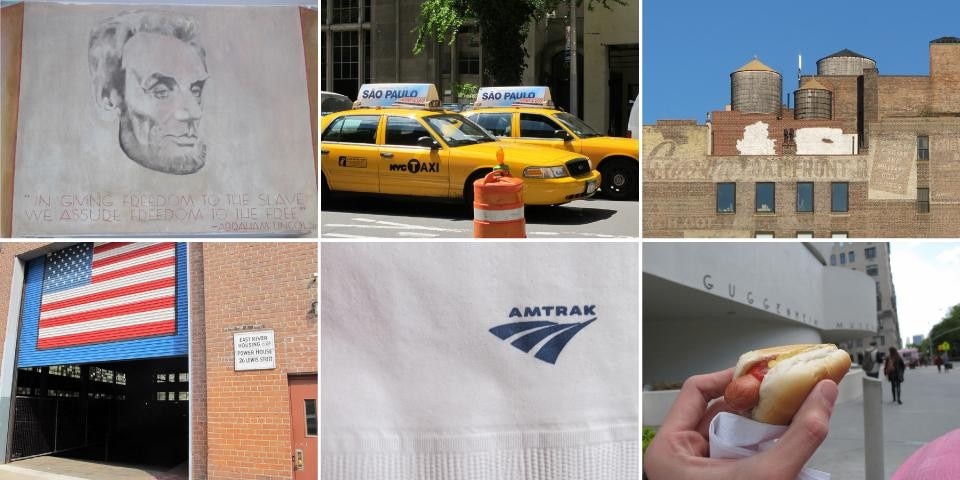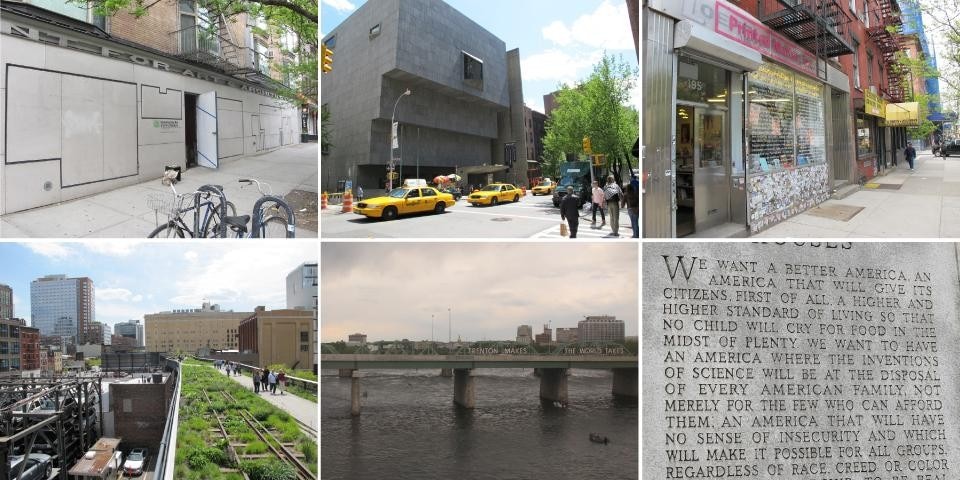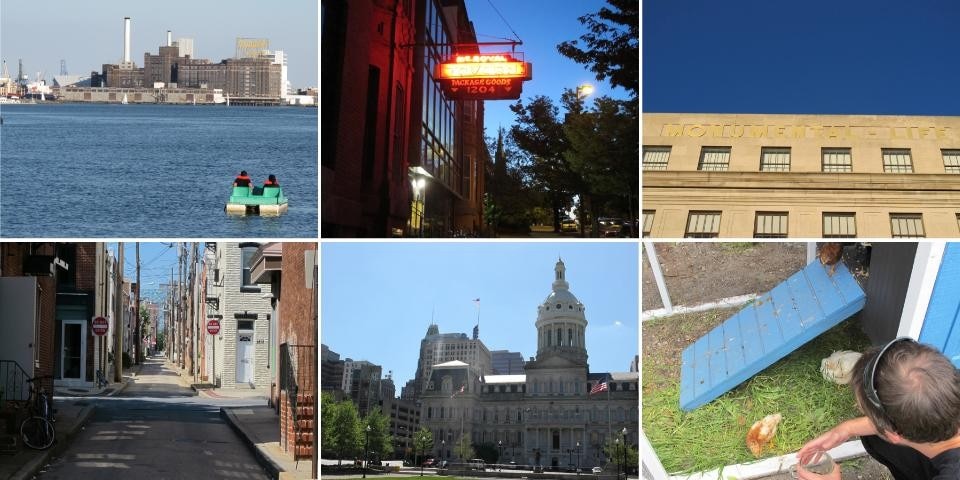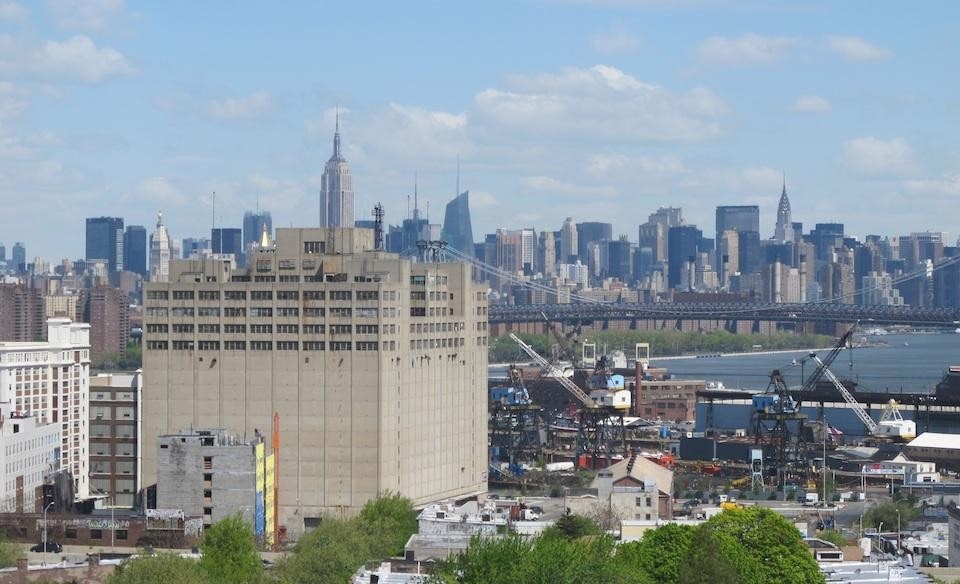I can't drive a car. I never learnt, never needed to. The cities in England are smaller, human-sized, less ruled by the car. It's on an altogether different scale. But I'm going to be crossing America, the greatest car-loving nation on earth, without getting behind the wheel.
And so it begins, my road trip by rail across the States, all the way (hopefully) by glorious Amtrak. I'm coming to look at 8 cities and whatever I find in between. To New York, Baltimore, DC, and Pittsburgh, before heading to Chicago, Detroit, LA and San Francisco. It's a curious moment in America, and some of the riskiest and most interesting ideas for its future are incubated at the city level. I want to know what makes them tick; the challenges they're facing and why they are the way they are: by exploring the infrastructure and texture of these places, this country. I want to scratch beneath the tarmac and concrete and attempt to understand them somehow. I'm going to need friends to show me round, help me make sense of the nuances and issues that face each place, a local to guide me through. I'll be meeting a range of urbanists, architects, artists, and people who are passionate about their city, to show me a different take on their home.
When I first started thinking about this trip it all began with public space; how the cities that I know and love in the UK seem to be slowly becoming more closed off. Huge tracts of town centres being patrolled by private security guards and shut off at night; right of admission refused. I'd always (perhaps idealistically) assumed that my hometown was part mine, a shared ownership of the streets and squares, a right to interact and occupy them as I saw fit. More and more it seems the opposite, with shiny new shopping malls being built to replace the town centres that existed before them. These 'malls without walls' follow the footprint of the old city (as seen in Liverpool's new shopping 'destination', Liverpool ONE), but impose their own rules and regulations. No hoodies. No trouble. No way.
I wanted to come to America because the problems (and opportunities) facing cities in Europe seemed to be happening quicker here, and on a bigger scale. I wanted to come to Detroit and explore a city where the social and economic gaps have widened. And to LA and Orange County where the airbrushed streets and private estates become more cartoonish and hyperreal by the year. At least in my head they do. What happens in the gaps? The slack space?
What happens when the city is controlled and manicured, like Mission Viejo in Orange County? With their separate bylaws governing everything from the colour of your house, to whether you can hang your washing out. Is this really a positive thing? But above all, what happens next? This idea of the flux of city space also feeds into exploring the scale of America. I'm going all the way overland because I want to know how big it is. I reckon 46 hours on a train from Chicago to LA should really hit it home. How can a country this big have developed so fast in such a relatively short time? The mind boggles. And as a foreigner I'm interested in how America works. Is it really a united state? How is this motor nation going to have to change as the oil gradually runs out?

The city is huge, even coming from London, yet the fact that Manhattan is so defined both physically by the rivers, and spatially by the grid system, makes it easier to navigate. One thing that stays with me about New York is this way this grid system gives the environment a coherence. Of course many of the buildings in the city are beautiful, but there's also a significant number of absolute clangers. Yet the form of the grid system seems to make it all hang together, providing texture and making the city work.
By pure chance I've managed to time my visit to coincide with the Festival of Ideas for the New City, a conference and street festival downtown organised by the New Museum and several partners, including Storefront for Art and Architecture. Previous experience of architecture/urbanism festivals is that they tend to be unwieldy and scattergun in their approach, lacking a clear vision and difficult to get your head around, even as someone who'd be drawn to that kind of thing. But not here, from what I saw the well-defined geographical focus around the New Museum and Bowery, along with clear themes for each of the panel discussions made the conference hang together comfortably.
Coinciding with this city preoccupation, I went to the Mayoral Panel debate at the Cooper Union. Introduced by David Byrne (a hero), the panel was made up of Sergio Fajardo, former Mayor of Medellín, Colombia; John Fetterman, Mayor of Braddock, Pennsylvania; Greg Nickels, former mayor of Seattle; and Michael Nutter, Mayor of Philadelphia. Where are the women on the panel though? It seemed like a glaring omission, yet the visions set out by these progressive mayors included increasingly accepted ideas such as sustainability, and the role of creativity in cities, that were not part of the urban planning debates even ten years ago.
Sergio Fajardo discussed at speed his idea of 'social urbanism', educating the poor and marginalised communities within the city, and giving them new public spaces to congregate, interact, and be proud of. He talked about the importance of building the most beautiful buildings possible in the poorest neighbourhoods, as the rich can build their own. This really stayed with me, how sharing knowledge and improving social inclusion can genuinely lead to a lasting change. Without being too idealistic, the projects in Medellín were not only beautiful, but according to Fajardo, also led to a positive shift in the way these neighbourhoods worked together and were regenerated from within.
John Fetterman also stood out on the panel, not only for his stature, but because he is the Mayor of a small town in Pennsylvania with a population of just over 2,000 people. Braddock is located in the eastern suburbs of Pittsburgh, and is undeniably facing economic hardship with unemployment 300% higher than the national average. Fetterman has led the way with 'reinvention being the only option', starting projects to re-use vacant lots, to restoring the town's architecture and new urban agriculture projects, s. Similar to the work occurring in many Rustbelt towns and cities—some of which I'll be visiting further into the trip.
But back to the city itself, and a wander around the Seward Park Urban Renewal Area (SPURA) on the Lower East Side, with local boy Gavin Browning (formerly of Studio X, the architectural research lab at Columbia University) leading the way. The area's redevelopment began with a federal building programme for low income housing in the 1960's. Homes and businesses for former residents of the old tenements. Tracts of the area remain vacant, part of a battle of what constitutes appropriate development there; and it remains the largest patch of undeveloped land south of 90th St that's owned by the city.

From the way that residents have vocally got involved to fight for what development occurs on their doorstep there was a real sense of people having a say in the future of their area, playing a valid role and standing up for themselves, an almost socialist air to the project. This sense of socialism and the development being led by left leaning principles (rather than the bottom line) isn't something that I expected to find in the States; a country not known for it's welfare state and safety net for the common man/woman. From the Soviet-style murals in the lobby's, to hopes and ideas that underpinned the building programme in the first place, the sense of purpose, it was a breath of fresh air next to the condos and concierges elsewhere downtown.
From the way that residents have vocally got involved to fight for what development occurs on their doorstep there was a real sense of people having a say in the future of their area, playing a valid role and standing up for themselves, an almost socialist air to the project. This sense of socialism and the development being led by left leaning principles (rather than the bottom line) isn't something that I expected to find in the States; a country not known for it's welfare state and safety net for the common man/woman. From the Soviet-style murals in the lobby's, to hopes and ideas that underpinned the building programme in the first place, the sense of purpose, it was a breath of fresh air next to the condos and concierges elsewhere downtown.
The scale of it all feels vast. Block after block of affordable housing, elegant brick towers and more squat, stepped apartment buildings set in gardens; old (at least by US standards) churches, libraries and a theatre; and with park squares and groups of Grandmas chatting away on the shady benches. It's got it all.

All these megastructures were built with the idea you could beat poverty by design, that the brave new world of modern architecture could save us all. But in many cases these machines for living suffered neglect, poor management and are now viewed as massive architectural failures. The reality of their downfall is much more complex, with political whim, divisive housing policies, and modernists idealist intentions clashing against huge social problems. According to architectural theorist Charles Jencks, the demolition of Pruitt-Igoe marked the end of Modernism, the dream was finally over. The film itself is amazing, insightful, shocking, and transforms what was initially an architectural documentary into a call for social change. The residents themselves for the most part having fond memories of their time there, but not with rose-tinted glasses. It was just their home.
I have to confess, I wanted to come to Baltimore for two main reasons, almost obsessions of mine, John Waters and The Wire. In some ways, despite wildly different manifestations, both David Simon and John Waters are simply writing love letters to their city through film—however complex and sordid these representations may seem. To me The Wire is more that just drugs and guns, gangsters and 'the game'. It's an incredibly intricate multifaceted portrait of a city, an ode to Baltimore. The same with Hairspray and the other Waters films, with their campy eccentricity and massive clash of bubblegum and grit (with a nod and a wink).
On day two, cycling around the city with architect Fred Scharmen was incredible, the best way to see and understand the place. Speeding through the streets, it was like whizzing through the greatest historical hits of the last 100 years of Baltimore. Street after street of rowhouses, square and low-slung, with their stoops and back alleys tumbling down the hills to the harbour at Fells Point—a former port district now saved from the developer's wrecking ball and turned into a pleasant, if sanitised new leisure district. The port buildings scrubbed up and the harbour now complete with waterfront promenade. That's not to say it's all manicured, it's still a working port, with the smoke, dirt, grime that goes with it, as well as Domino's Sugar. All this standing in contrast to the Inner Harbor, all Disneyfied, botoxed and sparkling—or soulless depending on your point of view.
Someone said to me while we were there 'everyone in New York thinks they're weird and they're not, whereas everyone in Baltimore thinks they're normal and they're not'. Baltimore has something in the air. Charm City definitely earnt its name. These two eastern seaboard cities showed me the neighbourhoods, districts and local side of the American city, along with making me think about the whole scale of these places. It's a whole lot more foreign than I anticipated, and I wonder what DC, Pittsburgh and Chicago will deliver?
Tom Keeley is an artist and writer whose practice investigates and celebrates the peculiarities of the built environment.


